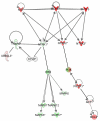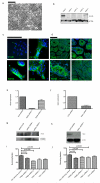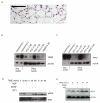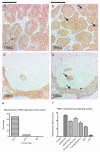Dysregulated TRK signalling is a therapeutic target in CYLD defective tumours
- PMID: 21552290
- PMCID: PMC3175103
- DOI: 10.1038/onc.2011.133
Dysregulated TRK signalling is a therapeutic target in CYLD defective tumours
Abstract
Individuals with germline mutations in the tumour-suppressor gene CYLD are at high risk of developing disfiguring cutaneous appendageal tumours, the defining tumour being the highly organised cylindroma. Here, we analysed CYLD mutant tumour genomes by array comparative genomic hybridisation and gene expression microarray analysis. CYLD mutant tumours were characterised by an absence of copy-number aberrations apart from LOH chromosome 16q, the genomic location of the CYLD gene. Gene expression profiling of CYLD mutant tumours showed dysregulated tropomyosin kinase (TRK) signalling, with overexpression of TRKB and TRKC in tumours when compared with perilesional skin. Immunohistochemical analysis of a tumour microarray showed strong membranous TRKB and TRKC staining in cylindromas, as well as elevated levels of ERK phosphorylation and BCL2 expression. Membranous TRKC overexpression was also observed in 70% of sporadic BCCs. RNA interference-mediated silencing of TRKB and TRKC, as well as treatment with the small-molecule TRK inhibitor lestaurtinib, reduced colony formation and proliferation in 3D primary cell cultures established from CYLD mutant tumours. These results suggest that TRK inhibition could be used as a strategy to treat tumours with loss of functional CYLD.
Figures









Similar articles
-
Transition from cylindroma to spiradenoma in CYLD-defective tumours is associated with reduced DKK2 expression.J Pathol. 2011 Jul;224(3):309-21. doi: 10.1002/path.2896. Epub 2011 May 19. J Pathol. 2011. PMID: 21598248
-
Overexpression of MYB drives proliferation of CYLD-defective cylindroma cells.J Pathol. 2016 Jun;239(2):197-205. doi: 10.1002/path.4717. Epub 2016 Apr 21. J Pathol. 2016. PMID: 26969893 Free PMC article.
-
Loss of heterozygosity at cylindromatosis gene locus, CYLD, in sporadic skin adnexal tumours.J Clin Pathol. 2001 Sep;54(9):689-92. doi: 10.1136/jcp.54.9.689. J Clin Pathol. 2001. PMID: 11533075 Free PMC article.
-
Cutaneous appendage tumors: familial cylindromatosis and associated tumors update.Adv Dermatol. 2005;21:217-34. doi: 10.1016/j.yadr.2005.06.005. Adv Dermatol. 2005. PMID: 16350444 Review. No abstract available.
-
Inherited cylindromas: lessons from a rare tumour.Lancet Oncol. 2015 Sep;16(9):e460-e469. doi: 10.1016/S1470-2045(15)00245-4. Lancet Oncol. 2015. PMID: 26370355 Review.
Cited by
-
Stabilization of p18 by deubiquitylase CYLD is pivotal for cell cycle progression and viral replication.NPJ Precis Oncol. 2021 Mar 2;5(1):14. doi: 10.1038/s41698-021-00153-8. NPJ Precis Oncol. 2021. PMID: 33654169 Free PMC article.
-
Tumor Suppressor Function of CYLD in Nonmelanoma Skin Cancer.J Skin Cancer. 2011;2011:614097. doi: 10.1155/2011/614097. Epub 2011 Dec 17. J Skin Cancer. 2011. PMID: 22235375 Free PMC article.
-
CYLD-mutant cylindroma-like basaloid carcinoma of the anus: a genetically and morphologically distinct class of HPV-related anal carcinoma.Mod Pathol. 2020 Dec;33(12):2614-2625. doi: 10.1038/s41379-020-0584-2. Epub 2020 May 27. Mod Pathol. 2020. PMID: 32461623 Free PMC article.
-
CYLD in health and disease.Dis Model Mech. 2023 Jun 1;16(6):dmm050093. doi: 10.1242/dmm.050093. Epub 2023 Jun 30. Dis Model Mech. 2023. PMID: 37387450 Free PMC article. Review.
-
CYLD GeneticTesting for Brooke-Spiegler Syndrome, Familial Cylindromatosis and Multiple Familial Trichoepitheliomas.PLoS Curr. 2015 Feb 19;7:ecurrents.eogt.45c4e63dd43d62e12228cc5264d6a0db. doi: 10.1371/currents.eogt.45c4e63dd43d62e12228cc5264d6a0db. PLoS Curr. 2015. PMID: 25737804 Free PMC article.
References
-
- Adly MA, Assaf HA, Nada EA, Soliman M, Hussein M. Human scalp skin and hair follicles express neurotrophin-3 and its high-affinity receptor tyrosine kinase C, and show hair cycle-dependent alterations in expression. Br J Dermatol. 2005;153:514–20. - PubMed
-
- Alvarez-Rodríguez R, Barzi M, Berenguer J, Pons S. Bone morphogenetic protein 2 opposes Shh-mediated proliferation in cerebellar granule cells through a TIEG-1-based regulation of Nmyc. J Biol Chem. 2007;282:37170–80. - PubMed
-
- Arévalo JC, Waite J, Rajagopal R, Beyna M, Chen Z-Y, Lee FS, et al. Cell survival through Trk neurotrophin receptors is differentially regulated by ubiquitination. Neuron. 2006;50:549–59. - PubMed
Publication types
MeSH terms
Substances
Grants and funding
LinkOut - more resources
Full Text Sources
Miscellaneous

